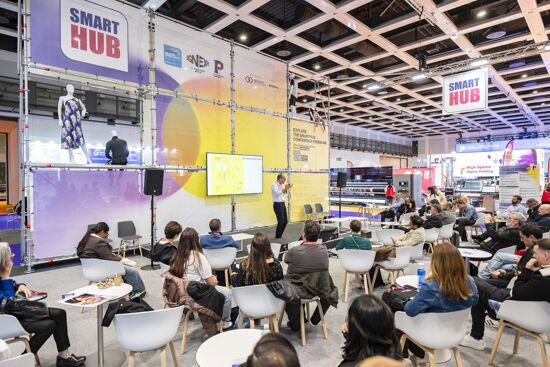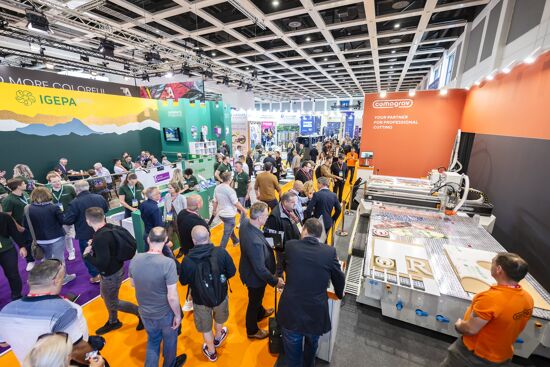It’s boom-time for digital textiles – are you ready for the opportunity?

Michael Ryan, Head of Global Print Expo at FESPA, discusses the growth opportunities, trends and technological developments in digital textile printing.
With the global digital textile print market set to reach $8 billion by 2030, new opportunities are opening up for enterprising print professionals. Thanks to technological advancements being made in roll-to-roll (R2R) and direct-to-garment (DTG) printing, many textile print producers have opted to replace their flat screen-printing machines in favour of more efficient digital textile printers.
Now is the ideal time for printers, regardless of their size, to assess their current technology set-up to see whether improvements can be made, enabling them to capitalise on this increase in demand for printed textiles. Let’s take a closer look at how the market for textile print is changing and why digital is fuelling its future.
One of the biggest drivers behind this significant growth in the textile print market is the rise of on-demand printing. Success comes to those printers that can meet and beat the turnaround times of others and adopt leaner and smarter ways of working. By keeping stock levels to a minimum, printers can enable customers to be more agile and respond to new market trends. Digital technologies also promote design diversity, eliminate waste and reduce the footprint of commercial manufacturing.
As the supply chain flexes to meet consumer demand, near-shore garment manufacture will gain traction and some producers are already choosing to bring technology in-house. In future, internationally sourced garments will be economically replaced by ‘home-grown’ products to reduce the carbon footprint of shipping costs and meet tighter turnaround times.
Thanks to digital technologies, we’re also seeing a burst of creativity in a generation of creative textile entrepreneurs. By using small scale, low-volume production machinery built for cottage industries, these textile producers have carved a niche for themselves, driven by e-commerce, great design and super-fast fulfilment.
Another sector that’s growing at a phenomenal pace is the DTG market. It's driving the fashion fulfilment business model whereby a print provider hosts online products for third-party production on behalf of designer-makers, offering them a turn-key manufacturing solution.
There have been improvements in printheads, such as the Ricoh GEN5 and the Xaar Nitrox, and further evolution in digital print processing, such as the Durst P5 in-line sublimation model. We’re also seeing a progression in ink handling, as exemplified by the Kornit XDi proposition and the DuPont Artistri 5500 inks.
There is equal progress in automation software which also has a big part to play in the reduction of production timescales in the custom garment sector. We’re seeing that the rate of adoption of digital printing technologies and software in traditional manufacturing operations is accelerating significantly. Using automation, customised garment production can be simplified as the software takes control of team logos, numbers, colours and other variable data with the touch of a button.
Across the industry, innovation continues and these advances are driving significant change. We are at a tipping point, a pivotal moment that offers the textile industry the toolbox, the technology, and the supply chain demand to move to environmentally responsible, efficient production.
At FESPA, we’re witnessing the impact that innovative technologies, automated processes and the increase in eco-friendly materials are having on textile production. We believe that digital technologies can make a huge impact, leading us into the next decade with enhanced processes, intelligent manufacturing, green production and smart retailing.
Digital textile print is the key to the future and will give PSPs the ability to unleash their creativity, delight their customers and create new revenue streams paving the way to future growth and profitability.
Make sure to keep up-to-date with the latest trends and advancements in textile printing via our FESPA.com news portal: https://www.fespa.com/en/news-media.
Topics
Interested in joining our community?
Enquire today about joining your local FESPA Association or FESPA Direct
Recent news

Industry Experts Explore the Evolution of Smart Manufacturing in the Textile Industry
A FESPA SmartHUB roundtable at Personalisation Experience 2025 discussed smart manufacturing's transformative impact on the textile industry. Experts highlighted the shift to on-demand customisation, driven by digital printing, data analytics, and automation. Key takeaways included enhanced machine control, significant waste reduction through intelligent software and colour management, and improved sustainability via energy efficiency and near-shoring, ensuring agility and environmental responsibility in textile production.

FESPA 2025 gathers leading visionaries from across the speciality print industry in Berlin
FESPA Global Print Expo 2025, European Sign Expo and Personalisation Experience (6 – 9 May 2025, Messe Berlin, Germany) welcomed Visionaries from across the speciality print industry to shape the future of print, develop forward-thinking business strategies, and explore innovative ways to translate emerging industry trends into tangible growth opportunities.

Exploring Cutting-Edge Textile Printing Innovation with Adobe Print Engine 7
Adobe PDF Print Engine 7, launched at FESPA Global Print 2025, significantly advances textile printing. Debbie McKeegan shares how it automates non-white substrate management and RGB colour handling, expands colour gamuts with in-RIP multicolour transparency blending, and streamlines workflows for efficiency and sustainability. This update boosts customisation, reduces waste, and positions businesses at the forefront of digital print innovation.

FESPA Global Print Expo 2025 - Overall Highlights
FESPA Global Print Expo, Europe's leading print and signage exhibition returned to Messe Berlin from 6 - 9 May 2025.